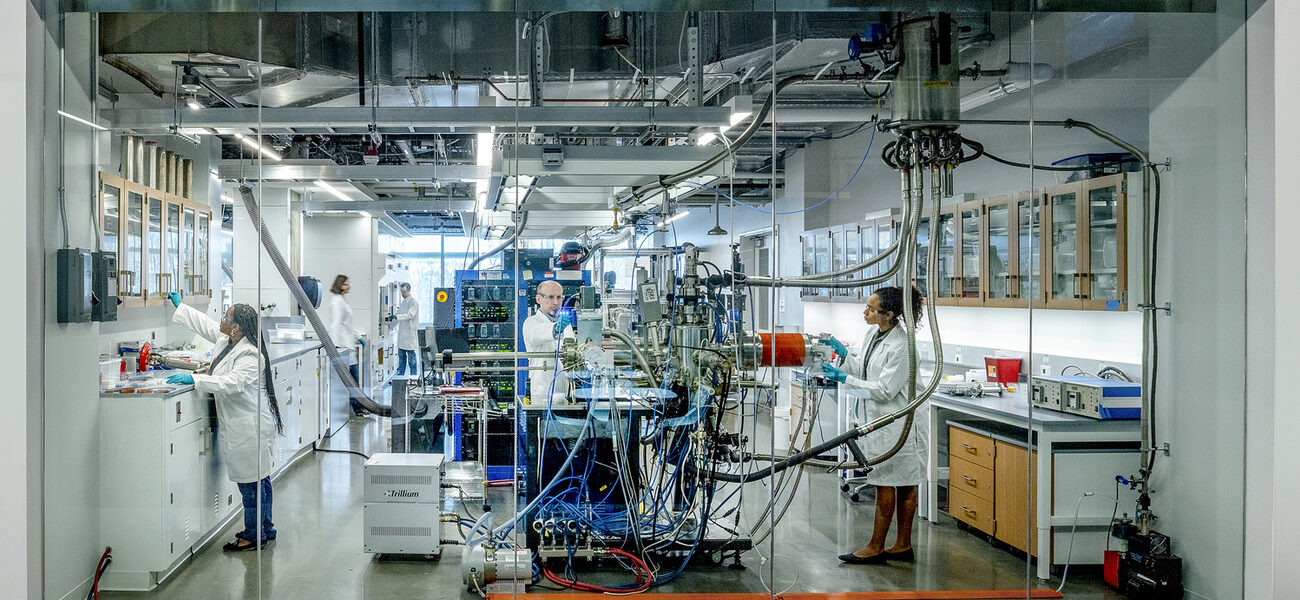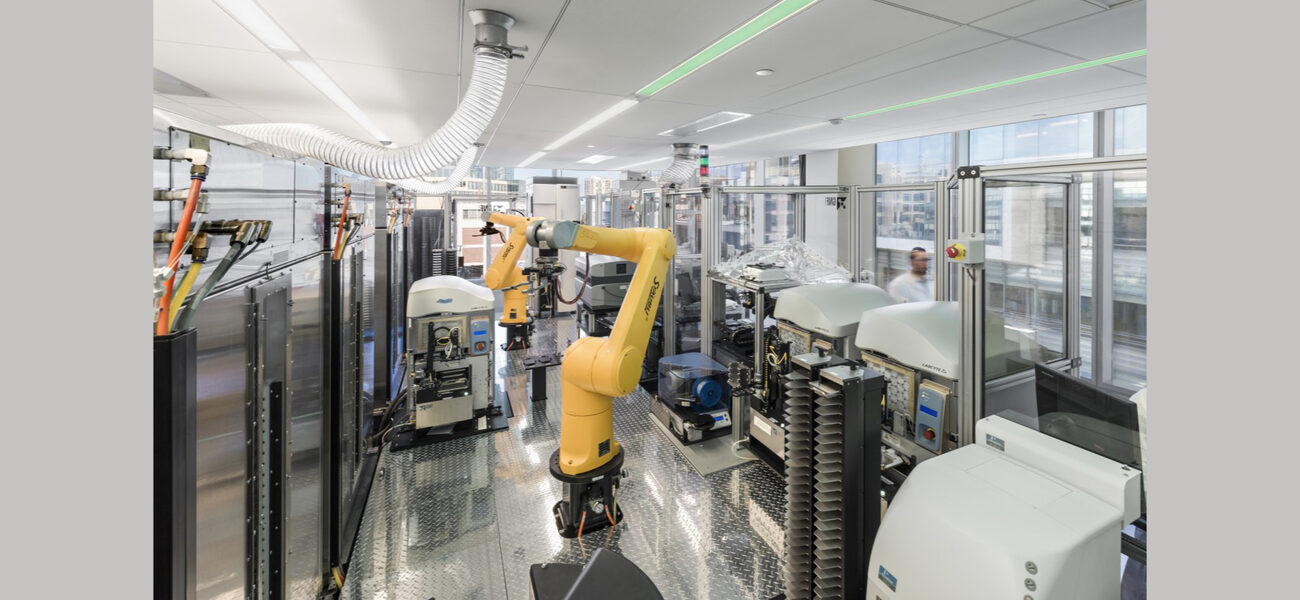The past few decades have brought myriad technological changes to our daily lives, and experts predict the pace of change will only increase—especially in the use of artificial intelligence (AI) tools. Much of the talk surrounding AI focuses on automating repetitive processes and analyzing data, which require additional computational power but not necessarily structural modifications. But emerging technologies, including AI and robotics, may require universities and companies to rethink their approach to designing and planning buildings and labs.
“Despite many discussions about AI’s application and the scientific workplace, we don’t have a completely integrated and built example or a full understanding of what this physical environment may look like,” says Tzveta Panayotova, principal of science and technology and market leader at CannonDesign in Boston. “As architects and planners, we need to be at the forefront of envisioning what the new built reality may look like. There is also a learning curve as it takes years to plan, design, and build a building.”
Building Designs May Change
Labs being constructed or planned today follow a traditional grid, and planners may be averse to unknown technologies, explains Panayotova, which means owners will have to retrofit or adjust as technological advances take hold. A discipline that incorporates more robotics into its labs might need larger, connected open spaces, whereas life sciences labs that utilize AI will allow for greater flexibility in floorplan designs and integration. Current research lab planning uses scientific equipment, bench dimensions, and ADA and code compliance as guides, forming a typical lab module generally planned on a repetitive grid. But with the emergence of new tools supplemented with AI, the conventional type of rigidity may not be as applicable as before.
“The research spaces we plan may not need to be purely based on a rectangular framework,” says Panayotova. “The buildings of the future will probably be more fluid and flexible.”
It’s unclear what research space of the future will look like because so much of this is currently theoretical. Robotic facilitators may need room to maneuver, whether that means traveling to a charging spot at night or moving throughout a lab to gather materials. And AI tools will spark new conversations about sustainability, as demand grows to consume significant amounts of electricity, putting a strain on cooling capacities.
New security measures may also be needed, not only to allow people to move throughout a building but also to constantly adjust access to certain types of information. AI can curate communication materials for smart surfaces, for instance, displaying what’s relevant and authorized based on which type of visitor is in the area. Depending on a person’s security clearance, information might include details of what’s happening in various labs to keep researchers updated on each other’s work. For visitors, such as funders or student tour groups, displays might show only high-level presentations. Panayotova imagines a customized, interactive environment that allows people to control the amount of information they receive at any time, so they can feel productive but not overwhelmed.
“Customization and preference for personal priorities would be paramount,” says Panayotova. “I envision the future as a scientist who walks down a hallway and has information displayed to them that is relevant to their research, schedule, or current needs, whether it’s a reminder that you need to pick up your child at a certain time or a discovery in the lab that you haven’t seen yet—a screen or a surface could send an alert. It’s the effective world of integration of needs, wants, and goals as you go about your daily life.”
Efficiencies Can Lead to Creativity and Profit
AI is particularly good at sifting through vast amounts of data to extract knowledge. A researcher can ask an AI tool to review every known journal publication about a particular topic and return relevant results in less time than it would take that person to read and analyze a single report. Offloading tedious tasks like this will give scientists more time for creative ideation and experiment design.
“It is estimated that about 40% of the tasks that a researcher does every day are repetitive, and they don’t need to spend their energy, time, and mental capacity on them,” says Panayotova.
AI, machine learning, and robotics already have the potential to increase research efficiency, which could equate to increased profits for life sciences companies by helping them bring new drugs to market more quickly. A study by the McKinsey Global Institute estimated that generative AI could generate $60 to $110 billion in economic value yearly for pharmaceutical and medical product industries.
Human Psychology Still Matters
The basics of day-to-day life will continue to play a role, even as new technologies take hold. When Panayotova introduces principal investigators to a new scientific workplace, their first question is often related to the location of the coffee machine on the floor and their workplace seat.
But the way scientists operate and think about their work will need to change to take full advantage of AI’s benefits. This may already be happening. A worldwide survey of 200 researchers from large pharmaceutical companies and life sciences startups, published in a 2024 Lab of the Future report by Pistoia Alliance, asked what hindered their use of experimental data. Thirty-five percent said institutional resistance to data sharing and collaboration was a factor; that represented a significant drop from the 48% who gave that answer in the previous year’s survey.
“I heard recently that in healthcare and drug exploration, scientists were not open to sharing research and development that can lead to a product that could be commercialized and manufactured,” says Panayotova. “But they were more willing to share explorations that failed, so others wouldn’t waste time going down the wrong path.”
That same 2024 Pistoia Alliance survey showed what researchers wanted to make data findable, accessible, interoperable, and reusable (FAIR) within their organizations:
- 49%: more data governance frameworks
- 46%: templates for standardization and metadata
- 51%: maintenance and management of data standards and ontologies
Nearly 50% also wanted to see use cases that demonstrated AI would actually work to optimize their workflow, while 42% of respondents wanted training courses on how to use AI and machine learning in the lab.
“The 42% who want to further their understanding of new technologies are a group to watch,” says Panayotova. “Those are the people who want to take the new tools and find ways to optimize their processes, and who will innovate and develop different ways of conducting science.”
Academia Could Help Lead the Way
At a recent Massachusetts economic development event on AI implementation, most of the panelists came from universities. When Panayotova asked about industry representation—since corporations can implement new tools more quickly—the group responded that ideas often start with academia.
“Having a think tank of academics developing certain ideas and then industry that tests and figures out what works fast is a powerful integration model,” says Panayotova. “The answer is not as simple as providing more servers, data bandwidth, and fiber optics. The bigger question is, how are we responding to the unknown and how are we positioning ourselves to have a better outcome in the built environment we create today and space typologies that will serve the future?”
By Amy Souza



